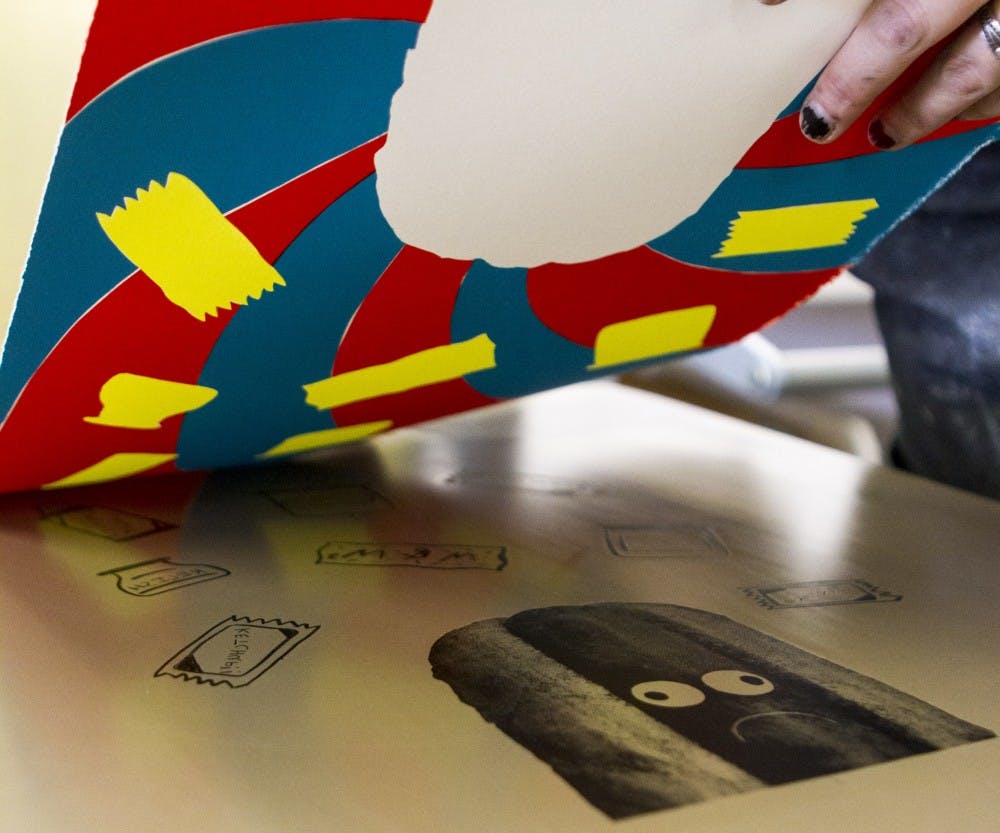culture@dailylobo.com
@StephenMontoya9
A rare art form is being rolled out, put under pressure and hung out to dry at the Tamarind Institute across the street from UNM.
The Tamarind Institute, along with UNM’s Fine Arts Department, is reviving the art of stone lithography while teaching the importance of collaboration.
Shelly Smith, marketing and development director for Tamarind, said the institute is under the College of Fine Arts, but it is in its own division with students applying from all over the world.
“When our students come here, they sign up for a couple of classes across the street, but most of the work they do is here at the institute,” Smith said.
Students come to Tamarind with a background and concentration in lithography, she said.
“We take students that have a background in lithography, who want to go on to teach or start their own workshop,” Smith said.
Tamarind is the only institute in the world that focuses on collaboration between lithography artists and printers, she said. The institute takes on only eight new students each year.
“For me, what’s exciting is when we can take artists that work in another medium and pair them with a master printer or student printer,” Smith said.
When Tamarind started, there were only four master printers in all of the United States, she said.
“It was a dying craft, and that was what Tamarind was founded to do, was to revive fine art lithography,” Smith said.
The art process starts with a greasy image drawn onto a lime stone. Then water is applied. Next, a grease based ink is placed on the image with a roller. The ink repels from the water and sticks to the image. Paper is placed on top of the mixture and then run through a high pressure press. What is left is a highly detailed image on paper that can take up to three weeks to dry.
Get content from The Daily Lobo delivered to your inbox
UNM Masters in Fine Arts candidate Lindsey Schmitt said she takes this class in collaboration with the Tamarind students as mentors.
“We tell the Tamarind student collaborators our idea or design and then they help us produce it,” Schmitt said.
Interviewing for this pairing happens a semester ahead of time, she said.
“Tamarind is the NASA of print shops so that’s why I wanted to come here.” Schmitt said. “Drawing on the stone is as sexy as a Cadillac.”
Dallas native Mary Poole said she heard about the Tamarind Institute from a professor at University of Texas where she was studying printmaking in the fine art department. She applied soon after, but was waitlisted for a year, she said.
A year later, she was invited to enroll for the fall 2013 semester, she said.
“My partner and I picked up and moved last summer, We ended up changing our whole lives to come out here and do Tamarind,” Poole said.
After she leaves Tamarind, Poole expects to spend a lifetime learning this difficult and expensive art form, she said. Poole said she would like to open her own shop and teach printmaking, while collaborating with other artists.
“It’s not a hobby, like sketching or drawing, you have to buy a press and you have to buy a stone which are very expensive. There are limited resources for this type art as well,” Poole said.
The students at Tamarind work long hours seven days a week at the Institute in order to perfect the process of print making.
Rodney Hamon, Tamarind’s education director, said he was looking for his calling as an undergrad almost three decades ago when he got a chance to learn lithography.
“A friend of a friend said ‘hey you should check out this class in the printmaking room, they’re doodling on rocks’ and I saw it for myself and fell in love with the process,” Hamon said.
Hamon earned his master print certificate in 1987 and began teaching printmaking at UNM in the ‘90s. He joined the Tamarind staff as the head professor to help continue the lithographic tradition, he said.
“When Tamarind formed in 1960 with the mission of training master printers along with artists, it helped to make the explosion and the accessibility of lithography in shops and at universities more popular,” Hamon said. “It’s my wish, our wish, to always see it alive out there, we don’t want to see it completely die off.”
Tamarind student Justin Andrews said he relocated from Sacramento, California to study at the institute.
“When I was an undergrad, I was at UC Santa Cruz. My litho instructor was a former Tamarind master printer, so that’s how I became familiar with the institute,” Andrews said.
Teaching printmaking at a collegiate level and going on to do collaborative work is one of the ways of utilizing this program’s potential, he said.
“I think just the combination of a highly technical printing process combined with a very broad creative spectrum that litho provides is a beautiful thing,” Andrews said.
Students in the lithography training program at the Tamarind Institute are collaborating with UNM’s College of Fine Arts to present the Rock Paper Pressure exhibit starting on Friday.
Box
Rock Paper Pressure
Tamarind Institute
Open Monday through Friday from 9 a.m. until 5 p.m.
Runs through May 15
2500 Central Ave. S.E.
Free
For more information, call 277-3901






